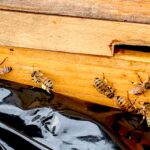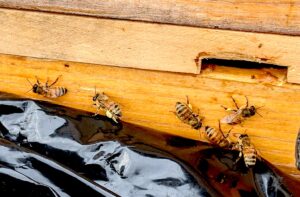
By Fred Bouchard
Sit in your backyard by the flowers and watch the bees go about their busy business. Notice their different sizes, colors, and flight patterns. Chubby, buzzy bumble bees—yellow-striped, black-bottomed—cram into white roses. Slender, darting honeybees—tawny orange, pinstriped—slip in and out of pink weigela. (Smaller, faster bees have eluded my view, for now.)
Are these garden denizens simply honey-gathering, pollen-spreading automatons? Not so, says author Stephen Buchmann in What a Bee Knows:
“Watch closer: she may be using olfactory tools to give her a 3-D map of her surroundings. She may gather information from the movements of other hive members. If she takes a milli-second ‘bud-break’, she may even dream. What goes on in poppy-seed-sized bee brains is far more advanced than we ever imagined. In their unending quest to feed their hives and store honey, they navigate complex landscapes, choose suitably ripe flower beds, react to climate shifts.”
“Bees have a memory of a few weeks,” says Belmont beekeeper Ottavio Forte. “But if I move a hive, they will soon reorient to it. The CIA uses them as drug-sniffers; bees are less troublesome and easier to maintain than dogs.” Nobel Prize winner Karl von Frisch explained the complexities of honeybees’ “waggle dance” that precisely communicates, in intricate figure-eight movements, the location of (say) a nectar source to hive members.
Sophisticated pheromones aid inter-communication within the hive. Honeybees have recently been found to adjust their spatial maneuvers strategically to effectively “social distance” themselves from the incursions of parasitic mites.
Tireless workhorses in pollinating 40% of our nuts, fruits, and legumes (not to mention sustaining the universe of flora), bees have become victims, decimated by diseases and commercial agricultural practices. Current research is scrutinizing brutal methods employed in industrial hive management; in one egregious example, we’re learning that millions of bees die annually in the pollination, production, and harvesting of California almonds.
What can home gardeners do to help the bees? The “No Mow May” non-movement has caught on. Leave your mower in the garage and/or use it less frequently and with a high (4- or 5-inch) blade setting; leave most clippings for natural mulch and compost the rest. Multiple benefits of this hands-off approach include pop-ups of clover, buttercup, dandelion, and daisy; extra nectar for bees; prosperity for the healthy underworld of bugs, microorganisms, and the silken carpet of the mysterious mycological network.
Fred Bouchard is a Belmont resident and member of the Belmont Citizens Forum Newsletter committee.



Sorry, the comment form is closed at this time.